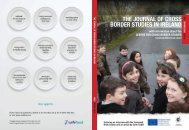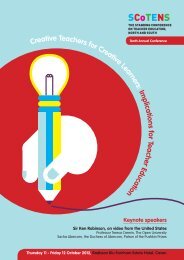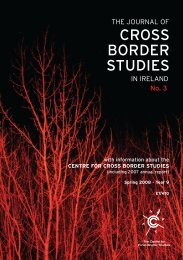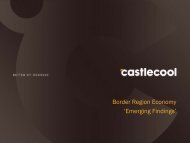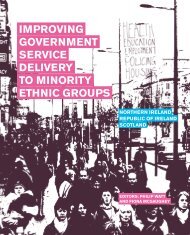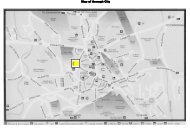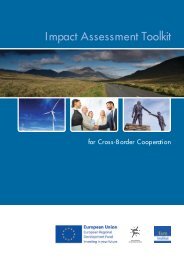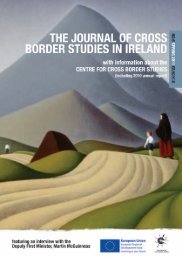4858 Mental Health Report - National University of Ireland, Galway
4858 Mental Health Report - National University of Ireland, Galway
4858 Mental Health Report - National University of Ireland, Galway
You also want an ePaper? Increase the reach of your titles
YUMPU automatically turns print PDFs into web optimized ePapers that Google loves.
Findings from the Compatibility and<br />
Comparability <strong>of</strong> <strong>Mental</strong> <strong>Health</strong> and<br />
Related <strong>Health</strong> Data Sources<br />
How would you rate your quality <strong>of</strong> life:<br />
Very poor Poor Neither poor nor good Good Very good<br />
1 2 3 4 5<br />
The Schedule for Evaluation <strong>of</strong> Individual Quality <strong>of</strong> Life (SEIQoL) is an Irish<br />
developed scale which measures general quality <strong>of</strong> life from the perspective <strong>of</strong><br />
the individual respondent (Browne et al. 1997). The individual names five areas<br />
most important to their quality <strong>of</strong> life, describes current functioning in each <strong>of</strong><br />
the areas and outlines the relative weighting or importance they give to each<br />
area in their judgement <strong>of</strong> quality <strong>of</strong> life.<br />
Psychological distress<br />
Psychological distress was measured by seven surveys (four in Republic and two in<br />
North) each using the GHQ-12. The GHQ-12, a widely applied instrument to<br />
indicate psychological distress, is the short form <strong>of</strong> the General <strong>Health</strong><br />
Questionnaire (GHQ) designed by Goldberg (1978) as a self-administered<br />
instrument for use in community settings. The cross national survey also<br />
measured psychological well-being using the Questionnaire on Resources and<br />
Stress (QRS-F) and life satisfaction using the Philadelphia Geriatric Centre Morale<br />
Scale. Many <strong>of</strong> the other mental health indicators were recorded by single surveys<br />
only.<br />
<strong>Mental</strong> and Physical <strong>Health</strong> Problems<br />
Each national survey recorded information relating to self-reported mental and<br />
physical health morbidity and health service utilisation. As was also the case in<br />
the regional or specific population surveys, reported diagnosis <strong>of</strong> depression and<br />
anxiety were the most commonly noted mental health problems. Those needing<br />
mental health services were identified in the <strong>Health</strong> and Social Services for Older<br />
People survey using the Hospital Anxiety and Depression Scales (HADS). Among<br />
the depression scales used in individual surveys were the Zung Self-Rating<br />
Depression Scale (Zung 1965) and the Centre for Epidemiologic Studies<br />
Depression Scale (CES-D) (Radl<strong>of</strong>f 1977). Physical morbidity was mainly recorded<br />
using the long term limiting illness indicator.<br />
Social Support and Stress Measures<br />
The Northern <strong>Ireland</strong> Survey <strong>of</strong> <strong>Health</strong> and Social Wellbeing survey used the same<br />
perceived social support seven item scale as that in the <strong>Health</strong> Survey for England<br />
1994. However, there was no such comparable measure in the <strong>National</strong> <strong>Health</strong><br />
and Lifestyle Survey in the Republic <strong>of</strong> <strong>Ireland</strong>. Respondents were asked about<br />
their perceived level <strong>of</strong> stress in the past year in the Northern <strong>Ireland</strong> national<br />
survey but not in the Republic’s.<br />
98





